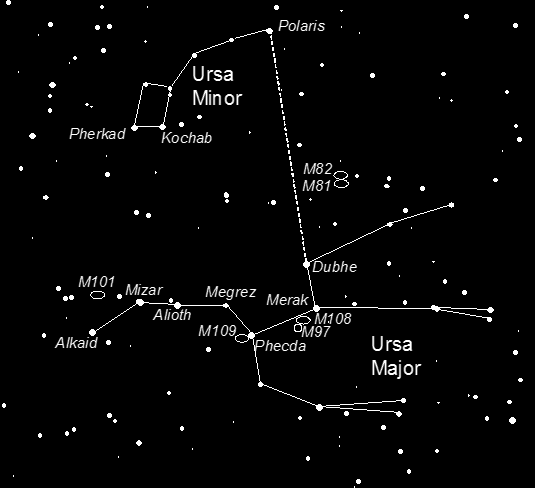Ursa Major & Ursa Minor

Mizar & Alcor: Famous naked eye double. Binoculars show a third star rejoicing in the name of Sidus Ludovicianum which is not thought to be physically related. A telescope further splits Mizar itself into one of the most attractive doubles in the sky. Alcor and both components of Mizar are all also spectroscopic binaries, with the fainter component of Mizar consisting three stars.
Xi (not shown on chart):
Another historically important double – the first to have its orbit computed, proving that Newton’s law of universal gravitation has truly universal application rather than just being an explanation of how the Solar System works.
M81 & 82 (Bode’s Nebulae): Two of the brightest galaxies in the sky, both visible in the same low power field. M81 is a classic spiral, like a smaller version of M31. M82 looks like an edge on spiral in amateur telescopes, but larger instruments show it to be quite unusual. It is thought to be in the process of colliding with a vast cloud of intergalactic dust and it is a strong radio source.
M101: Large face on spiral galaxy. Despite an integrated magnitude of 7.7 its low surface brightness makes it a fairly challenging object.
M97: Planetary nebula known as the “Owl”. The detail that gives rise to this name is beyond the range of most amateur telescopes which show just a grey featureless blob. As a bonus however, another of the Messier galaxies (M108) appears in the same low power field.
Polaris: Famous for being the star about which everything else in the sky appears to rotate. In fact it is pure coincidence that the Earth’s axis is pointing towards a fairly bright star at this time. An effect called the “precession of the equinoxes” will gradually move the North Celestial Pole away from Polaris after its closest approach at the turn of the next century. Polaris is also an attractive double star and a Cepheid variable. It is however the only real object of note for amateurs in Ursa Minor.
Messier mix-ups: The definitive catalogue of bright deep sky objects is undoubtedly the list compiled by Charles Messier in the 18th century. There are however some strange omissions and inclusions to this list. Two of the strange inclusions, M40 & M102, are associated with Ursa Major. M40 is a faint double star close to Megrez, once mistakenly thought to be surrounded by nebulosity. M102 is most likely a duplicate observation of M101 rather than the galaxy NGC5866 in the neighbouring constellation of Draco as has been suggested in the past.
POWERPOINT SLIDE SHOW (301KB)